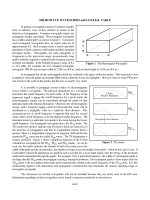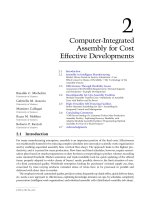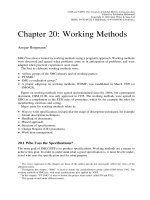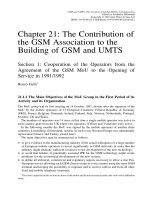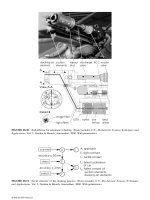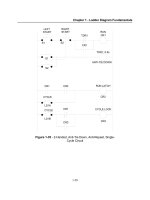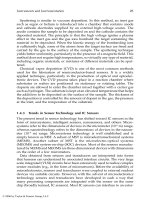ERFORMANCEI Peter Willmott and Dennis McCarthy pptx
Bạn đang xem bản rút gọn của tài liệu. Xem và tải ngay bản đầy đủ của tài liệu tại đây (11.64 MB, 270 trang )
AROUTETO
I
iES3
PERFORMANCE
Peter Willmott and
Dennis McCarthy
TPM
-A
Route
to
World-Class Performance
TPM
-
A
Route
to
World-Class
Performance
Peter Willmott and
Dennis
McCarthy
UTTERWORTH
EINEMANN
Oxford
Auckland Boston Johannesburg Melbourne New
Delhi
Butterworth-Heinemann
Linacre House, Jordan Hill, Oxford OX2 8DP
225
Wildwood Avenue, Woburn, MA 01801-2041
A division of Reed Educational and Professional Publishing Ltd
A member of the Reed Elsevier plc group
First published 2001
0
Peter Willmott and Dennis McCarthy 2001
All
rights reserved.
No
part
of
this publication
may be reproduced in any material
form
(including
photocopying or storing in any medium by electronic
means and whether
or
not transiently
or
incidentally
to some other use
of
this publication) without the
written permission
of
the copyright holder except
in accordance with the provisions
of
the Copyright,
Designs and Patents Act 1988 or under the terms
of
a
licence issued by the Copyright Licensing Agency Ltd,
90
Tottenham Court Road, London, England WlP 9HE.
Applications
for
the copyright holder’s written permission
to reproduce any part
of
this publication should be
addressed to the publishers
British Library Cataloguing in Publication Data
A catalogue record for this book is available from the British Library
Library
of
Congress Cataloguing in Publication Data
A
catalogue record for this book is available from the Library of Congress
ISBN
0
7506
4447
8
Vpeset at Replika Press Pvt Ltd,
100%
EOU, Delhi 110 040, India
Printed and bound in-Great Britain by
Biddles Ltd, Guildford and King’s Lynn
Contents
Foreword
by
Sir Ken Jackson
Preface
Acknowledgements
Glossary
of
TPM
terms
Putting TPM into perspective from Total Productive
Maintenance to Total Productive Manufacturing
Assessing the true costs and benefits
of
TPM
The top-down and bottom-up realities of TPM
Techniques to deliver TPM principles
The TPM improvement plan
Applying the TPM improvement plan
Planning and launching the TPM pilot
Managing the TPM journey
TPM for equipment designers and suppliers
10
TPM in administration
11
Case studies
Index
vii
ix
xi
Xlll
1
17
23
62
78
116
145
165
181
193
212
247
Foreword
The global market means we all have to reach world-class levels of performance.
Those of
us
that don’t will be left behind. Big or small, private or public;
there’s no hiding place from the winds of change.
That’s why the AEEU recognized the value of TPM some years ago.
We
saw then that TPM could enable manufacturing and services industries to
become the best in the world.
Unlike TQM, which was conceptually sound, but patchy in outcome, TPM
offers a new and invigorating approach. Involving everyone from shopfloor
to boardroom, TPM is a team-based and freshly focused tool for success.
And it can really help Partnership work. In many ways, it’s the missing
link. TPM shows that cost reduction doesn’t just mean redundancy. Rather, it
offers the opportunity for managers and the workforce to share the gains
from reducing waste and boosting productivity and performance.
Two years ago,
I
launched a new initiative called ’Partners in Success’.
Built around the principles of TPM, it showed how unions and employers
could raise their game and then share the rewards. And that message hasn’t
changed.
And it’s a pleasure to recommend another WCS publication on TPM. The
AEEU has worked closely with Peter Willmott, Dennis McCarthy and others
for some time now. We’ve been spreading the TPM message
-
at the DTI,
throughout industry and at conferences and seminars in the
UK
and across
Europe.
That’s why this book will help organizations meet the challenges of the
new knowledge economy. It is a tool for change and a guide through new
markets. It ought to be on every practical manager’s bookshelf.
Sir Ken Jackson
General Secretary
AEEU
Preface
Customers expect manufacturers to provide excellent quality, reliable delivery
and competitive pricing. This demands that the manufacturer’s machines
and processes are highly reliable. But what does the term ’highly reliable’
really mean?
Certainly, with manufacturing, process and service industries becoming
progressively dependent on the reliability of fewer but more sophisticated
machines and processes, it means that poor equipment operating performance
is no longer affordable or acceptable. The overall effectiveness of our machines,
equipment and processes is paramount to provide consistency of product
quality and supply at a realistic price.
Coping with modern manufacturing technology that is intrinsic in the
materials, mechanisms and processes which we invent, design and use is one
issue. Delivering the manufacturing company’s vision and values as a lean,
just-in-time producer to its customers, shareholders and employees is another.
Some world-class Japanese companies recognized over twenty-five years
ago that the effective application of modern technology can only be achieved
through people
-
starting with the operators and maintainers of that technology
-
and not through systems alone. Hence the emergence of total, productive
maintenance as the enabling tool to maximize the effectiveness of
our
equipment
by setting and maintaining the optimum relationship between people and
their machines.
The problem with the words ’Total Productive Maintenance’
-
and hence
the philosophy or technique of TPM
-
is that, to Western ears, they sound as
though TPM is a maintenance function
or
a maintenance department initiative.
But it is
not!
On the contrary, TPM
is
driven by manufacturing which picks
up production and maintenance as equal partners: it is no longer appropriate
to say ’I operate, you fix’ and
’I
add value, you cost money’. What TPM
promotes is: ’We are
both
responsible for this machine, process or equipment
and, between us,
we
will determine the best way to operate, maintain and
support it’. Perhaps a better way of describing TPM, therefore, is to think of
it as Total Productive Manufacturing, as it picks up operations and maintenance
as equal partners under the umbrella of manufacturing.
The problem of definition has arisen because the word ’maintenance’ has
a much more comprehensive meaning in Japan than in the Western world.
If
you ask someone from a typical Western manufacturing company to define
the word ’maintenance’, at best he might say, ‘Carry out planned servicing at
fixed intervals’; at worst he might say, ’Fix it when it breaks down’.
If
you
ask
a Japanese person from a world-class manufacturing company, he will probably
say, ’Maintenance means maintaining and
improving
the integrity of our
production and quality systems through the machines, processes, equipment
and people who add value to our products and services, that is, the operators
x
Preface
and
maintainers of our equipment’. Whilst this may be a longer definition, it
is
also a more comprehensive and relevant description. Hence it is now more
appropriate to think of TPM as Total Productive Manufacturing.
Over the last few years, certainly since the advent of the
1990s,
a growing
number of Western companies have, with varying degrees of success, adopted
the Japanese TPM philosophy. The companies who have been successful in
using TPM in their operations have recognized and applied some key success
factors, including:
You
must enrol and secure the commitment
of
senior managers from
the start.
0
TPM is led by manufacturing.
0
TPM is
a
practical application
of
total quality and teamwork.
TPM is an empowerment process to give shared responsibility and
ownership.
0
The TPM philosophy is like a heart transplant: if you don’t match it to
the patient, you will get rejection.
You
must, therefore, treat each company
or recipient as unique and
adapt
the principles of TPM to suit the local
plant-specific issues without corrupting the well-founded and proven
principles of TPM.
Total Productive Maintenance, an original Japanese management protocol
developed to alleviate production losses caused by machine breakdowns,
has moved on. Through TPM, more companies now accept the concept of
zero breakdowns as achievable. From the foundation
of
striving for zero
breakdowns, world-class plants are able to run for complete shifts without
the need for intervention. TPM is still pushing back the boundaries of what
was thought possible. This does not mean that people are no longer needed.
On the contrary, it is the ingenuity of operators, maintainers, engineers and
management, working as full members of the company team, which makes
such progress possible, often working as a positive ’partnership for change’.
Based on our experience of working with world-class companies, this book
provides a practical guide to delivering TPM benefits within cultures where
professional cynics have had years to practise their craft. Based on the proven
principles of TPM, the book emphasizes the need to build on existing good
practices and to win commitment
by
delivering results. It is based on the
author’s first-hand experience
of
seeing TPM in Japan and then adapting
those principles to suit the strategic needs of companies across four continents.
It builds on Peter’s earlier book
TPM
the Western Way,
updating the scope of
applications and tools. It includes more detail on the ‘life after pilot’ as well
as the application of TPM to equipment design, administration and non-
manufacturing areas. The TPM route map is updated to include the journey
to zero breakdowns and beyond. It also provides a systematic structure to
evolve from the classic Total Productive Maintenance towards Total Productive
Manufacturing and, hence, deliver a Totally Productive Operation capable of
world-leading performance.
Peter Willmott
Dennis McCarthy
Acknowledgements
Since the first edition of this book some five years ago, we have had the
privilege of working with some really good people who share our passion
and belief in the potential power of the TPM philosophy.
This shared passion came from touching TPM in practice rather than
theory.
So
here, we would like to express our sincere thanks to some of those
good people.
Our many clients continue to be our main source of inspiration through
the priority, pace and resources they apply to the TPM process and their
operations to gain and sustain competitive advantage. We are particularly
indebted to:
Derek Cochrane and Derek Taylor of 3M
Chris Rose and Clive Marsden of Adams
Les Thomson and Mike Milne of BP Amoco
Ian Barraclough of Elkes Biscuits
Gordon Hill and Mike Williamson of Henkel
Danny McGuire and Ken O’Sullivan of RHP Bearings
Grant Budge and many others at
RJB
Mining
The
UK’s
Department of Industry, specifically through Peter Dalloway,
Robin Crosher,
John
Gillies and Richard Amott, has actively supported practical
research, such as the ’TPM Experience’ project aimed at identifying and
disseminating ’TPM Best Practice’. This provides an excellent example of
government working in partnership with industry, and long may it continue!
In spreading the TPM message via conferences, workshops and study
tours, the roles played by David Willson of Conference Communication and
John
Moulton and Tom Brock of Network Events, plus
John
Dwyer and
Paddy Baker of Findlay Publications, are all acknowledged with gratitude.
Also Doug Osman, formerly a Team Leader at Hoechst Trespaphan, has been
an avid supporter of the TPM philosophy at many of our workshops over the
years.
A
special word of thanks is due to our colleagues in WCS International
who have provided much of the inspiration, perspiration and material for
this book, and to Heather Scott-Duncan who undertook the onerous task
of
word-processing the text.
Particular thanks also to Sir Ken Jackson, General Secretary of the AEEU,
for his kind contribution in writing the foreword to this book,
and
to
Lynn
Williams, National Officer, AEEU, who has been an effective and influential
missionary for TPM over the last several years.
Last, but not least, our gratitude to our wives for having the patience to
support us and for creating an environment which has given us the time to
write this book.
